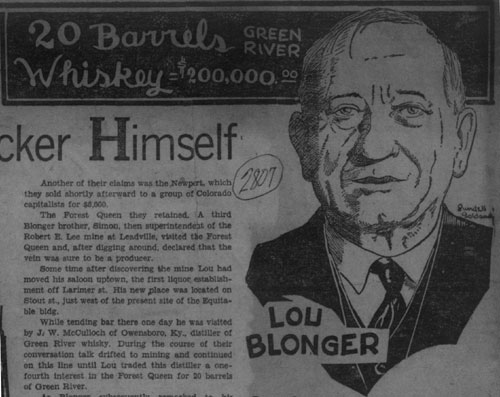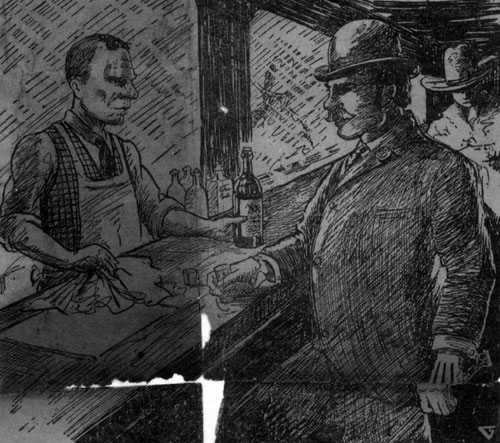|
|
Bunco King Was A Sucker Himself. |
|

(Denver?) Evening News, date unknown
WHEREIN IT IS SHOWN THAT DENVER'S
Bunco King Was A Sucker Himself
BY RICHARD C. MARKEY
(Evening News Staff Writer)

Lou Blonger, the human shark who preyed on "suckers," was a sucker himself.
The king of the buncs, as he was known far and wide, disposed of a veritable fortune in order that he might ply his chosen trade of taking the gullible and unsuspecting "hicks" to a trimming.
Had he devoted his energies to lawful pursuits which were open to him he might be alive today with a good fortune to his name instead of being dead; he died while wearing prison garb in the state penitentiary at Canon City.
Tho it cannot truly be said that Lou lived a hand-to-mouth existence, or that he died in abject poverty, he did live in a state of constant fear of law enforcement. On his death he left his widow an almost insignificant estate.
Altho it is not generally known, Lou was the discoverer of a very rich vein of ore, which, if he had retained and mined, would have netted him a generous living and augmented his estate.
TOURISTS WERE HIS MEAT
But Lou, following his mania for "trimming the suckers," became the "brains of an extensive bunco ring which reaped a harvest of thousands and possibly millions from the tourists who visited Denver and Colorado Springs.
As such, he was one of many who landed in the net cast by Frank Norfleet, Texas nemesis of the bunco men. For his activities in this respect Lou drew a prison term. It was while serving this term that Blonger, an aged and broken old man, died behind prison bars.
But to get back some years and to that part of Blonger's life which is not known to the general public, which remembers him only as a slicker - Blonger was one of the early pioneers of Colorado and the old railroadless West.
He was born of a family of hardrock miners at Shellburg, Wis,. then a prosperous mining town. Tales of unlimited gold fields and other opportunities in the West induced Lou to leave his family and follow the advice of Horace Greeley.
A detailed story of his trip west over the plains is lacking, but many incidents attached to it were related by Blonger to his intimate friends.
According to the story, Lou with a brother, Sam, left their home in Wisconsin in the '60's, in one way or another they crossed the country to Fort Kearney, Neb. The situation of the brothers became known to General Kearney, who was then in command at the fort.
KEARNEY FORBIDS THEIR TRIP
Because of the active warfare being waged by the Indians in the West against travelers whom they considered were infringing on their preserves, General Kearney refused to allow the youths to continue their trip.
They remained at the fort for nearly six months, during which time their only shoes were worn from their feet. Then, when the opportune time arrived, they left the army garrison and started across country barefooted and with only meager provisions.
Their perilous journey was never discussed at length by either of the brothers. Indians in roving bands were active at the time against all travelers of the plains and many harrowing experiences must have been undergone by the boys.
They continued their journey to Salt Lake City, where, after a time, Lou got work as a rider for the Wells-Fargo Express Co. His duties in this position were to ride the stage coaches and guard the gold bullion carried from the flourishing western mining camps to the U.S. mint at San Francisco. He worked at this for a time, while his brother Sam worked in Nevada mines, which produced some of the gold which was shipped under Lou's protection.
Some years later the brothers returned to Colorado. Denver, then an infant city, was the trading post for numerous mining expeditions which were headed toward mining communities of the state.

OPENED SALOON ON LARIMER.
Here they entered the saloon business on Larimer st., operating a wide-open gambling house in connection. In both games they were competitors of the famous "Soapy" Smith, whose fame as an out-and-out gambler was not limited to this state.
Despite ample earnings from this business the lure of hidden gold constantly beckoned to Lou and ofttimes he would take a vacation from his business to visit the new mining camps which were springing up about the state.
In 1891 the Iron Clad Hill district, several miles east of Cripple Creek, was opened. It was while visiting there that Lou, with W. H. Gibson, left the gaming tables and hiked into the hills on a prospecting trip.
They staked out several claims, among them one which Lou named the Forest Queen, in honor of his wife, who, prior to her marriage to him, was an actress and clog dancer. They were married at Tombstone, Ariz.
Another of their claims was the Newport, which they sold shortly afterward to a group of Colorado capitalists for $8,000.
The Forest Queen they retained. A third Blonger brother, Simon, then superintendent of the Robert E. Lee mine at Leadville, visited the Forest Queen and, after digging around, declared that the vein was sure to be a producer.
Some time after discovering the mine Lou had moved his saloon uptown, the first liquor establishment off Larimer st. His new place was located on Stout st., just west of the present site of the Equitable bldg.
While tending bar there one day he was visited by J. W. McCulloch of Owensboro, Ky., distiller of Green River whisky. During the course of conversation talk drifted to mining and continued on this line until Lou traded this distiller a one-fourth interest in the Forest Queen for 20 barrels of Green River.
As Blonger subsequently remarked to his patrons, "that should be wonderful whisky. It cost me enough."
McCulloch's one-fourth interest has paid to him and to his estate more than $200,000 and is today paying goodly dividends with no indication of immediate exhaustion.
Blonger, according to friends, also gave away other shares in the property to friends, some of who still retain an interest.
The claim to the Forest Queen was patented in 1893 and was granted the fall of that year.
First work on the property was done that same year by John War, generally known as Long John, and Joe Findley, who was known as Alderman Joe.
They worked it for two years and then a lease to the property was given to Captain Pruett and General Reardon. The latter had been postmaster at Victor, Colo. Both put money into the venture and worked it until 1903 when they gave it up.
A lease was then given to John M. Roach, a Chicago street car magnate. He also put money into the mine and it was under him that the first material work was done. A shaft was sunk to a depth of 600 feet, the ore from which yielded him sufficient to cover his expenditures.
Then in 1910 the lease was taken over by John Connors of Denver. Connors prior to coming to Colorado had mined in all the rich strike camps of the country in California, Nevada, New Mexico, Colorado and was one of those who had answered the call of the Yukon in the '90s.
COMPANY STILL CONTROLS IT
At that time the mine was owned by Auraria Mining Co., named after the early settlement which is now Denver. This company was made up of L. H. Blonger, R. W. Steele, J. W. McCulloch, Mrs. Anna Barney and Mrs. O. W. Jackson. This company with its original members or their heirs still control it.
Connors, thru his wide experience, had looked over the gold vein of the Forest Queen and decided it would be a rich paying producer.
Every gold mining camp is replete with tales of penniless prospectors who strike it rich in a relatively short time, and this may be said of Connors. Soon after taking over the lease he proved the worth of the vein by making one of the most sensational strikes in the district.
Since taking it over in 1910, Connors has had the mine in continual operation with the exception of several years during the war. The workings now consist of 1,060 feet of tunnels on nine different levels.
The ore now being mined, while not as rich as that struck in the early days of the mine, is said to be of a medium grade. A crew of 15 to 20 men is working daily and shipments totaling 15 or more cars of ore are being made monthly.
At current gold prices this means a return of from $10,000 to $15,000 a month.
YIELDED MORE THAN $2,000,000
During the life of the mine it has yielded more than $2,000,000 worth of ore and the vein is now said to be about 15 feet wide, which indicates that it will not be worked out soon.
During the last few years the mine has been equipped with the latest modern machinery. This includes an air compressor, electric hoist, drill sharpener and a skip for hoisting.
The Forest Queen is said today to be one of the most active and productive properties in the entire district.
Connors who [rest of sentence missing from copy]
"Lou was always a friend of the man who was down, especially the miner. Whenever he was approached for a handout, he never gave the bum a dime or a quarter but a $5 or $10 bill," Connors said.
ANOTHER STORY OF BLONGER
Another anecdote told of Blonger was an incident which occurred a number of years ago. He was seated in a saloon in the window of which was a large tank filled with many kinds of fish. A customer in the place asked the proprietor, "What kind of fish is that big one lying on the bottom?"
"Oh, that's a sucker," was the reply. It was no sooner out of the bartender's mouth than Blonger was on his feet saying, "Let me at him."
Still another one told on the occasion of one of the early-day excursions of tourists into Denver from Nebraska. Each tour had a director in charge.
One excursion train pulled into the depot and Blonger was on hand to meet it and see some of his Nebraska friends whom he knew were to be on it.
Much to his surprise, the director lined the excursionists up to give them directions as to where to stay and what to see and as a final shot added: "and keep away from Lou Blonger and his gang."
Lou, Sam and Simon are dead but the name of Lou will be remembered in Denver by at least those of the present generation and the Forest Queen will be his monument after that.
This clipping is undated and the city of publication is not given, but it seems fairly certain it was published in the Denver Evening News soon after Lou Blonger's death in 1924. Though there are numerous small factual errors in Lou's early history, in general this seems to be a fairly accurate account of the establishment of the Forest Queen. While it seems Lou must have traded something for 20 barrels of Green River whisky, whether it was actually a quarter stake in the Forest Queen is highly debatable.
|



